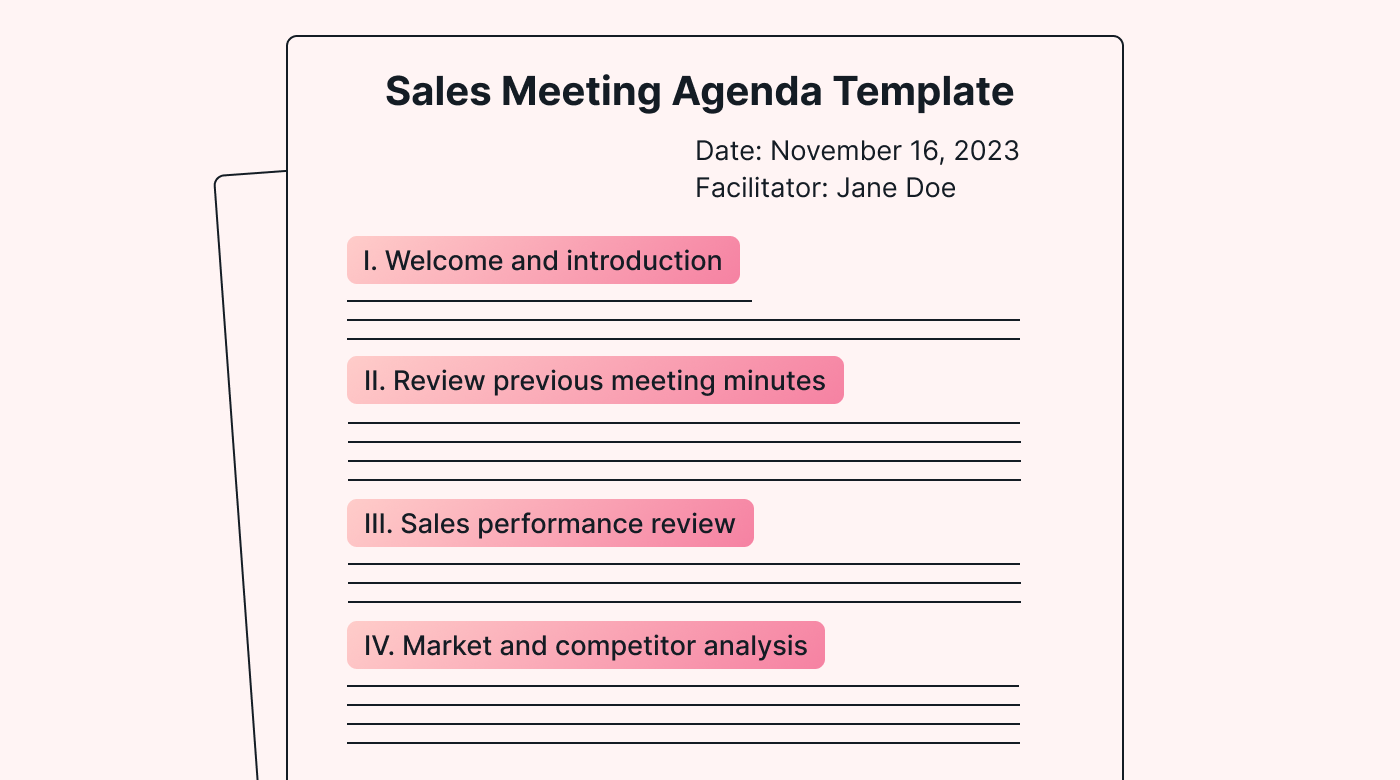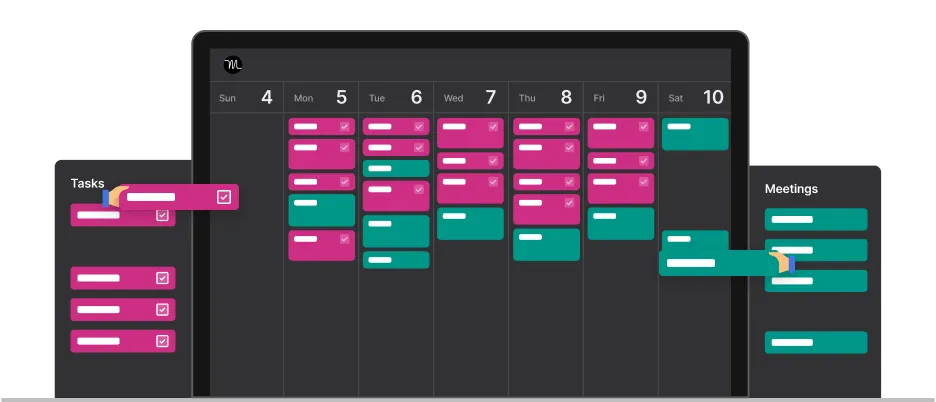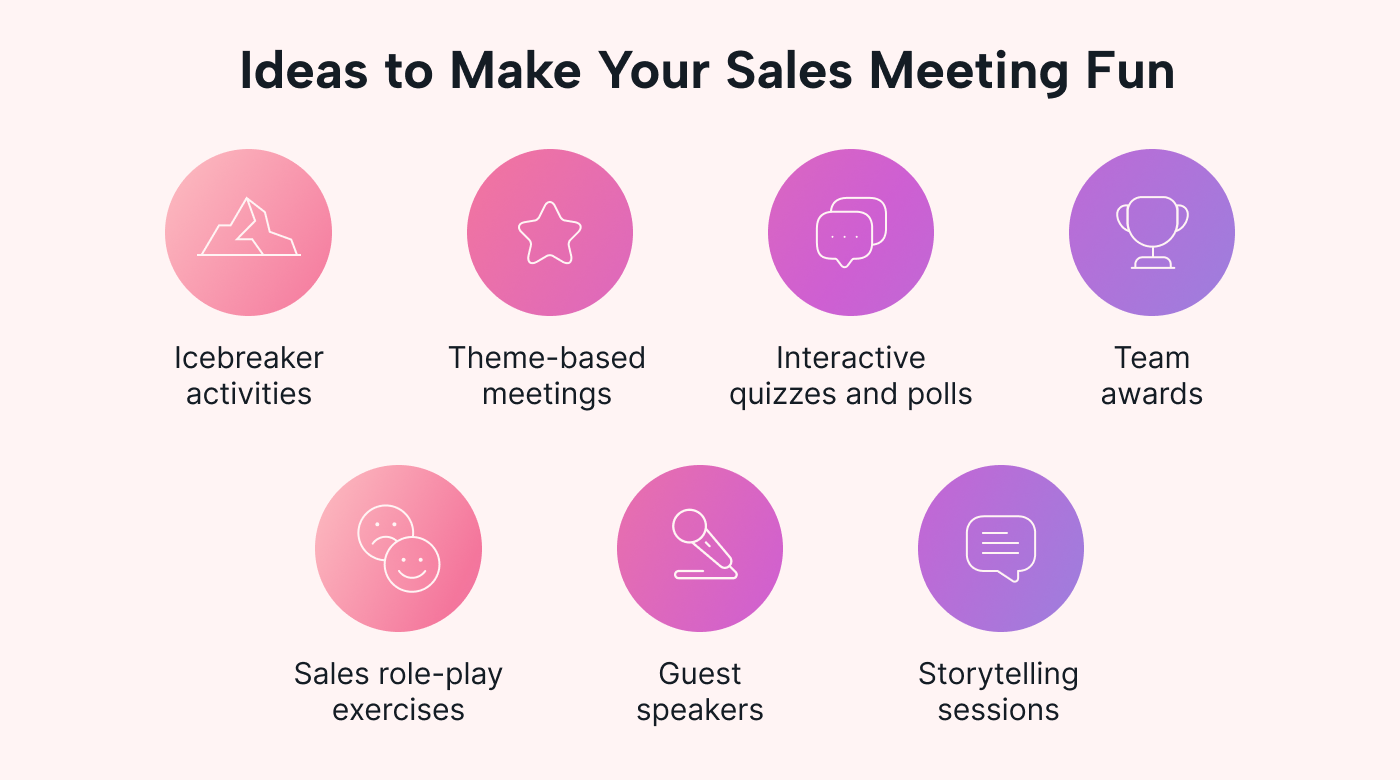A sales meeting agenda is a document that outlines the topics and activities that participants will discuss during a sales meeting. It helps to ensure that this important type of meeting stays focused and productive.
This guide provides an overview of important topics to cover in sales meetings, from performance reviews to market analysis. We’ve also included a customizable template to help you prepare for your next sales meeting.
Why are sales meeting agendas so important?
Sales meeting agendas help your meetings run smoothly, ultimately allowing your team to get more out of each session. Let’s explore why they’re key to a meeting’s success.
Provide structure and focus
A clear agenda allows the participants to prepare in advance. That way, everyone comes to the meeting ready to contribute their ideas. Agendas keep meetings on track and goal-oriented so that no discussion topics are left out.
Clarify the purpose of the meeting
Each agenda item should have a clear purpose, as this will help the participants understand the meeting’s goal. Also, making informed decisions and reaching a consensus happens faster when the objectives are clear from the start.
Furthermore, clarifying the meeting’s purpose makes it easier for team members to bring different perspectives to the table and find innovative solutions to challenges as a result.
Ensure better time management
Having a predetermined list of topics is a good time management technique. It helps prioritize the issues to be discussed, ensuring that all important topics are covered. It’s also a great way to respect your team’s time.
 |
Promote accountability and follow-up
Agendas can assign specific topics to individuals, making it clear who’s responsible for what. Regularly reviewing agenda items during follow-up meetings helps you track progress and hold team members accountable for their tasks.
Lay the foundation for collaboration
Agendas foster a collaborative environment in which team members work together on shared objectives because they outline topics that require group input. And regular, well-organized meetings that focus on collaboration help to build a team culture in which cooperation and mutual support are valued.
A well-structured agenda allows for balanced participation, giving everyone involved a chance to voice their opinion. When team members feel their contributions are valued and necessary for the meeting’s success, they’re more likely to be engaged and invested in the outcomes.
Sales meeting agenda template and structure
Below is a template for a productive sales meeting agenda and guidance on what to cover in each section. Keep in mind that this agenda is simply a guide, so you can modify it to suit the specific needs of your team and sales environment.
 |
Date: [Insert Date]
Time: [Insert Time]
Location: [Insert Location/Video Conference Link]
Facilitator: [Insert Name]
I. Welcome and introduction
- Welcome message
- Brief overview of meeting goals
- Introductions (if there are new members)
II. Review of previous meeting minutes and action items
- Summary of previous meeting outcomes
- Follow-up on previous action items and status updates
III. Sales performance review
- Review of current sales metrics and comparison with targets
- Discussion of individual performances
- Recognition of top performers
IV. Market and competitor analysis
- Update on market trends and customer insights
- Review of competitors’ activities and strategies
V. Product updates and training
- Information on any new products or updates
- Training on any new sales techniques or tools
VI. Customer feedback and case studies
- Analysis of recent customer feedback
- Discussion of recent case studies or success stories
VII. Sales strategy and goal-setting
- Reviewing and adjusting sales strategy
- Setting new sales goals for the upcoming period
VIII. Challenges and problem-solving
- Identifying current challenges
- Brainstorming to find solutions
IX. Success recognition and motivational activities
- Acknowledgment of recent successes and achievements
- Discussion of incentives and rewards
 |
X. Future opportunities and lead generation
- Presentation of new leads or opportunities
- Strategies for pursuing new business
XI. Action items and accountability
- Setting specific action items
- Assigning responsibilities and deadlines
XII. Open forum
- Open discussion for team members’ feedback and suggestions
- Addressing any other relevant topics
XIII. Conclusion
- Summary of key points and decisions made
- Confirmation of the next meeting date and agenda items
Topics to cover in a sales meeting
Try to ensure your sales meetings are both informative and engaging. Let’s take a closer look at the key agenda topics to cover in each of these sessions:
Sales performance review
Start by discussing the sales team’s performance. Highlight the team’s key achievements and areas for improvement. Use real examples to make the discussion more tangible and relatable to the team.
For example, instead of just saying, “We need to improve our customer engagement,” you could bring in a specific example such as the following:
Our team managed to close a deal with XYZ Company worth $50,000 last month. This success was largely due to our proactive approach toward understanding their needs and customizing our proposal.
Our team member Sarah noticed that XYZ’s team was struggling with inventory management, which our software could directly address. By focusing on this specific problem during our pitch, we demonstrated the direct value of our product to their business. This shows how important it is to fully understand a client’s pain points and tailor our approach accordingly. This had a major impact on our sales results. Well done, Sarah!
Market trends and analysis
Briefly touch on the latest trends in your market or industry. This keeps the team informed and can even spark ideas for new business strategies.
For instance, let’s say you’re in the software industry. Businesses are moving away from traditional on-premise software to more flexible, cloud-based services. In fact, according to one report, companies are striving to migrate 60% of their digital infrastructure to the cloud by 2025. As such, you should consider adjusting your sales pitches to emphasize the flexibility and scalability of your cloud-based products.
Sales goals and targets
Review the current goals and the team’s progress toward achieving them. Try to approach the topic with a balance of realism and optimism. This not only provides a clear picture of where the team stands but also encourages them to keep working hard toward their targets — and to share their strategies and challenges in the process.
Problem-solving session
Allocate time for the team to bring up any challenges they’re facing. Try to create an atmosphere in which every team member feels comfortable sharing their challenges.
Give each person a chance to voice the challenges they are facing. This can range from dealing with a difficult client to struggling with a particular software tool. The key is to listen actively and without judgment. Encourage the rest of the team to ask clarifying questions to fully understand each problem.
Once you’ve laid out the challenges, shift the focus to a group discussion and brainstorming session. Encourage the free flow of ideas, no matter how unconventional they may seem. For example, if a team member is struggling with time management, another might suggest a new project management tool they’ve found helpful or share strategies for prioritizing tasks.
Remember: a sales team meeting isn’t just about identifying problems. It’s also about promoting and sharing the team’s collective intelligence and creativity to find solutions.
7 tips for a successful sales meeting
Let’s dive into the art of running effective sales meetings. Here are seven practical tips to make your next sales meeting not only smooth but also successful:
1. Appoint a facilitator
Assign a facilitator for the meeting to guide the discussions, keep the meeting on track, and ensure all agenda items are covered. This can help maintain structure and efficiency.
2. Send the agenda in advance
Prepare and send a detailed agenda to the attendees before the meeting. This gives them time to prepare for the discussions and contribute to a more focused session.
3. Use calendar-blocking tools
The right team members must attend for a sales meeting to be effective. But with busy schedules and, often, multiple meetings to juggle, making sure that everyone who’s invited attends can be challenging.
 |
Motion’s calendar blocking tool helps to solve this problem by automatically reserving time in attendees’ calendars for the sales meeting. This not only ensures their availability but also helps prevent last-minute conflicts.
4. Motivate your team
Before diving into the agenda, spend a few minutes motivating your team. For instance, you could use positive affirmations, highlight recent successes, or share inspiring stories that are relevant to your team’s goals.
5. Use visuals and demonstrations
Use visual aids like charts, graphs, and product demonstrations. These tools can make complex information more understandable and help to keep the team engaged.
6. Keep the meeting interactive
Create an environment in which all team members feel comfortable sharing their ideas and feedback. Active participation leads to more dynamic and fruitful discussions.
Use interactive elements, like Q&A sessions, group discussions, or quick polls, to keep the team attentive.
7. Ask for feedback
Regularly ask for feedback on the meetings to identify areas for improvement. This can help make future meetings more effective and better tailored to your team’s needs. Taking suggestions also helps your team feel heard and makes sure they get the most they can out of their sales meetings.
Ideas for making sales meetings fun
Just because you’re following a structured agenda doesn’t mean your meetings have to be boring. Get your team involved and engaged with these fun activities:
 |
- Icebreaker activities: Start with a light-hearted icebreaker session. This could be a fun question, a quick team trivia game, or a humorous anecdote related to sales.
- Theme-based meetings: Hold meetings with sports, retro, movie characters, or other themes. Encourage team members to dress up or bring something related to the theme.
- Interactive quizzes and polls: Use quizzes or live polls on sales-related topics or fun trivia. Tools like Kahoot or Mentimeter can make this easy and interactive.
- Team awards: Recognize achievements in a fun way. For example, hand out humorous awards, like “Most Creative Pitch” or “Coffee Connoisseur.”
- Sales role-play exercises: Turn sales role-playing into a fun activity by adding scenarios with a twist or encouraging over-the-top performances.
- Guest speakers: Occasionally invite a guest, like a motivational speaker or a comedian, to add a fresh perspective and entertainment to team meetings.
- Storytelling sessions: Have a segment in each meeting where team members share interesting or funny sales experiences. This not only entertains but also offers learning opportunities.
Master efficient sales meetings with Motion
Forget about the hassle of juggling calendars and dealing with conflicting schedules in your sales team.
Motion is an innovative tool that revolutionizes meeting management by intelligently organizing and scheduling your future meetings. It seamlessly integrates into your workflow so that each sales check-in is well-structured and works for everyone.
By automating the mundane aspects of scheduling, Motion allows sales teams to focus on what matters the most — strategizing, collaborating, and closing deals.
Embrace Motion for smoother, more productive sales meetings that drive results and keep your team synchronized and motivated. Sign up for a free 7-day trial.





